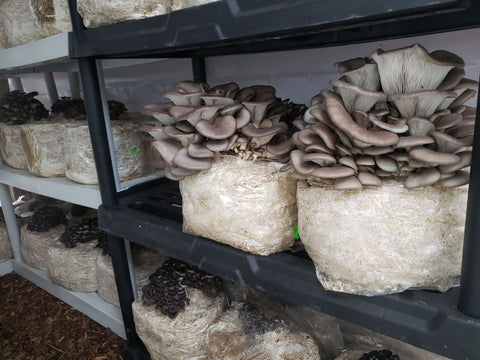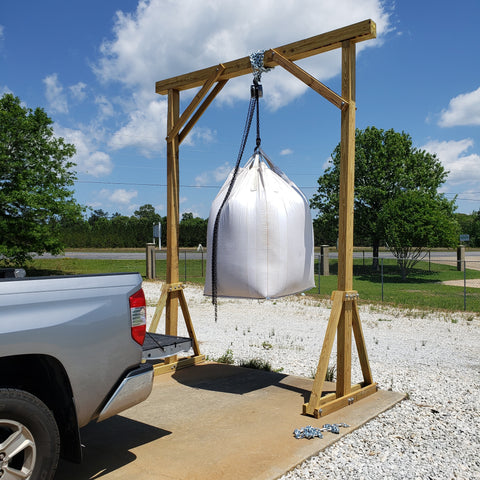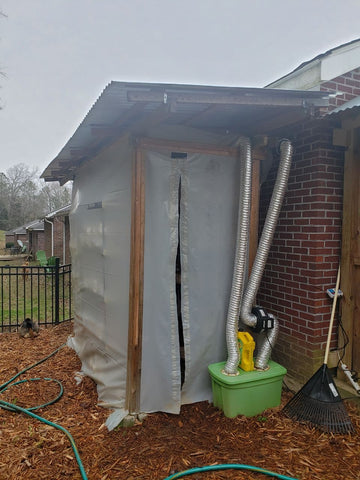Mushroom Agriculture 101
How to Start a Mushroom Farm
Introduction
Mushroom farming is an exciting new industry that continues to gain popularity among entrepreneurs looking for innovative ways to diversify their farms or operations by producing fresh mushrooms; if you're wondering how to start a mushroom farm then you're in luck! Fungi Farm is an industry leader in supplying mushroom cultivation supplies and education; our main goal is to support mushroom agriculture. This article will discuss a few of the most important factors to consider before starting a mushroom farm.
The picture below is from the backyard of a condo complex in Alabama where 50 lbs can be grown each week. This setup cost less than $1000

Educate yourself to become a successful mushroom grower!
Mushroom Farming is Still Young in North America
It's exciting that so many people are interested in growing mushrooms – they have been cultivated for thousands of years and there is always more to learn! Mushroom farming has many benefits over traditional agriculture; it's environmentally friendly, sustainable, efficient with space usage, low labor costs (when done right), and can be profitable if well planned out for small-scale operations.
Take it slow
It's too bad some people jump into mushroom farming without first learning about the industry. One of the issues is that there isn't much good information available online for mushroom growers; most mushroom farming literature comes from other countries which often use different species and cultivation methods. Another issue is that not many people are growing mushrooms in North America, so it's difficult to find mushroom growers who can offer advice on how to start a mushroom farm. Take the time to learn as much as possible from industry leaders, consultants, and other mushroom farmers; this will increase your chances of success when it comes to starting a mushroom farm.
Mushroom farms do not look like traditional farms

The Basics
Don't get overwhelmed
It can be overwhelming at first, but starting a mushroom farm is fairly simple. There are two options for starting your mushroom farm: indoor or outdoor. Indoor mushroom farming is the best option for serious year-round production. Outdoor mushroom farming is much cheaper but seasonal; not providing a year-round supply of mushrooms.
What is involved?
There are two main components to mushroom cultivation: spawn and substrate. The first component, spawn, refers to any material with mycelium on it that will be used to transfer mycelia into a substrate; this can be sawdust or grains that have been sterilized in a bag or jar. The second component, substrate, is what the mycelium will grow on (as a food source) to eventually produce mushrooms. Several different types of mushroom spawn can be used for cultivation: plug spawn, sawdust spawn, and grain spawn. Ready to fruit blocks are another form of spawn that comes pre-inoculated with the mycelium and is ready to fruit.
Varieties
It is important to note that there are different varieties of mushrooms, and each has its unique growing requirements. For instance, shiitake mushrooms prefer to grow on supplemented hardwood sawdust or logs as a substrate. Another example is oyster mushrooms which love growing in just about anything; these two varieties are by far the easiest mushrooms to start with.
General tips
Here are some tips for growing mushrooms: mushrooms need water! Make sure you keep your substrate moist at all times. The right temperature is also necessary; if the substrate gets too hot, your mycelium could overheat. Make sure to have good airflow. If the mycelium gets no oxygen, it will die. The post-harvest process is also very important. You must take care to store mushrooms properly until they are ready for sale or consumption.
Mushroom Farming is Difficult
You will face big challenges
I know I just mentioned growing mushrooms is simple, but you would have to be a mushroom farming expert to grow them all successfully. Despite how easy it is to start growing oyster mushrooms or lion's mane from ready to fruit blocks, other mushrooms can be very difficult to grow successfully. Mushroom farming can be very labor-intensive as well.
Make a plan
The type of mushrooms you want to cultivate make a big difference when deciding on your business model. Many factors make some mushroom species easier to grow (and sell) than others – like how quickly you will get a return on your investment or whether your end product is a fresh or dried mushroom. There is no way around it, you should do your research, choose the right species, and develop a plan before investing too much money into supplies or equipment.
Save money buying in bulk, but make sure you can move the material around!

Mushroom farming generates waste. Luckily, the waste is great compost!

Indoor mushroom farming
Overview
Growing mushrooms indoors requires less space than other types of agriculture but does have its own set of challenges. Mushroom farming indoors requires fairly expensive equipment, but there are several ways to save money when starting. For instance, by purchasing used equipment instead of brand new; it may not be pretty but will still work just fine for growing mushrooms. There are ways around spending too much on your initial setup; you just have to think outside the box a little bit.
The basics of indoor mushroom farming
The most popular substrate for growing gourmet edible mushrooms indoors is sterilized sawdust, either purchased as pre-inoculated blocks (ready-to-fruit) or prepared using spawn. Growing indoors allows for year-round production, meaning higher yields and less time between harvests. Many other substrates can be used to grow mushrooms indoors including straw, but they are not recommended for commercial production by industry leaders. Environmental control is an important aspect of indoor mushroom farming. The main parameters to consider are temperature, humidity, and ventilation. Mushrooms need light to grow, but not very much. Temperatures must be maintained between 55-65F for optimal results, conditions must be moist but not wet; mushrooms also produce CO2, so they require lots of fresh air; make sure to install proper ventilation. Garages, spare sheds, shipping containers, climate-controlled greenhouses, warehouses; even old chicken houses are great options for indoor mushroom cultivation structures provided the environment is properly controlled and maintained.
When getting started, a simple structure such as the one below can be used for seasonal production in a semi-indoor environment

The southeast provides wonderful weather for semi-indoor production for a large portion of the year

Outdoor, seasonal mushroom farming
If you choose to go the outdoor route, growing on logs is your best option. Outdoor farms can be more cost-effective to get started than indoor farms but only produce in certain seasons of the year- usually, spring and fall. Growing mushrooms this way also requires a larger space and longer initial time investment- logs require a lengthy spawn run (the time it takes the mycelium to colonize the log), sometimes continuing for up to a year before fruiting. Nevertheless, growing on logs is a fun and easy project anyone can do. Logs inoculated with mycelium can be purchased from a supplier and placed in your backyard or on wooded property, or you can inoculate them yourself. You just have to drill holes in the logs and stuff them with spawn, then wait for the mycelium to grow.
Inoculating logs
The logs must be fresh cut and disease free, then you drill rows of holes about an inch deep using a power drill, spaced about six inches apart. Insert the spawn into each hole using an inoculation tool; or if using plug spawn, tap in gently to make sure it is fully seated. Seal the holes with hot wax to prevent contamination and hold in moisture.
Taking care of your logs
It is important to keep an eye on moisture levels while growing mushrooms outdoors; if the logs get too wet, the mycelium will drown, and fruit bodies won't develop. If they get too dry, mushroom growth will be inhibited and the mycelium dies. Growing mushrooms outdoors requires patience but is fun and rewarding if you have the time.
Final thoughts
Mushrooms are a tasty, healthy, and sustainable crop to grow. The number of available products under the umbrella of "mushrooms" has increased exponentially in recent years. The demand for gourmet and exotic food has continued to increase, and there is a growing interest in extremely unique and high-quality food products. There is an increasing trend of consumers demanding locally sourced food products as well, which puts small mushroom farms in a prime position to take advantage of this growing market.
The future
As the trend of buying local food spreads throughout North America, more and more people are making an effort to find products that they can feel good about buying. Consumers are becoming more aware of the negative effects that large factory farming has on the environment, and they are willing to pay top dollar for locally sourced food. If you're looking to start your own business growing mushrooms, it's not too late. If you have the space and resources- growing them yourself is highly rewarding!
Learn more
If you are interested in more information on growing mushrooms check out the rest of our website and please reach out to us! You can visit our farm store in Dadeville, AL open Tuesday-Friday 10 AM to 3 PM, or attend one of our monthly onsite tours. Good luck with your mushroom farm adventure!

